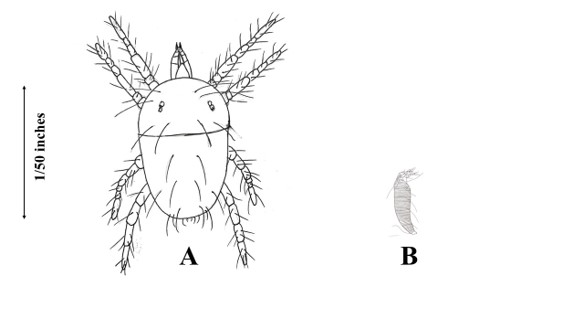
Plant feeding mites can cause serious damage in turfgrass systems, and drought-stressed turfgrass is particularly prone to mite infestation. Mites are generally active in turfgrasses from spring into fall. They feed on plant sap and, in some cases, also inject toxins into plant tissues or manipulate plant growth, thereby producing characteristic symptoms. Some mites do not directly damage the turfgrass but instead become nuisance pests by moving from the lawn to houses and other buildings. The worm-like (Eriophyidae) and spider-like (Penthanleidae or Tetranychidae) mites are important types of pests in turfgrass. Eriophyid mites are less than 0.2 mm long, which makes them microscopic. These mites are elongate or tube-shaped and specialize in specific turfgrass species, including bermudagrass mite, Eriophyes cynodoniensis Sayed, buffalograss mite, Eriophyes slykhuisi Hall and zoysiagrass mite, Eriophyes zoysiae (Baker, Kono and O’Neill). The spider-like mites are about 1 mm in length and can be seen with the aid of a hand lens (Fig. 1). These mites include banks grass mite, Oligonychus pratensis Banks, two-spotted spider mite, Tetranychus urticae Koch, clover mite, Bryobia praetiosa Koch and winter grain mite, Penthaleus major (Dugés).
1. Eriophyid mites
Bermudagrass mite
Biology
The bermudagrass mite is active during the spring and summer months in Georgia. It has a worm-like appearance, with mouthparts and two pairs of legs located at the anterior end of the body (Fig. 2). They undergo four life stages – egg, two nymphal stages, and the adult (Fig. 3). Females lay spherical eggs under the leaf sheath which hatch in 2-3 days. The lifecycle is completed in 7-15 days. This short lifecycle results in large mite populations during the summer.
Damage symptoms
The bermudagrass mite only damages bermudagrass (Cynodon spp.). It not only consumes the plant juices but also injects plant growth regulators into the plant tissues. Consequently, internodal stem length shortens, the turfgrass appears stunted, and the leaves become bushy (Fig. 4). The characteristic damage symptoms of bermudagrass mite feeding are leaf sheath swelling and witches broom. The symptoms start in the mid-spring and can result in the browning of grass blades in summer and thinning out of large areas of bermudagrass.
Management
Common and ‘Celebration’ bermudagrass are highly susceptible to bermudagrass mite. In one study ‘Tifsport’, ‘Cardinal’, ‘Midlawn’ and ‘GN-1’ resisted mite infestation for up to nine weeks during the season. These cultivars may not be commercially available in Georgia. Planting resistant varieties can help to prevent mite infestation. Replanting with other non-host grass species, such as zoysiagrass, is an alternate cultural management approach.
The symptoms of bermudagrass mite damage can be similar to drought symptoms. Please contact your local county Extension agent for proper identification of suspected bermudagrass mites. Cultural management practices include minimizing turfgrass stress through proper maintenance. Common miticides available to control other mites are ineffective against this mite pest.
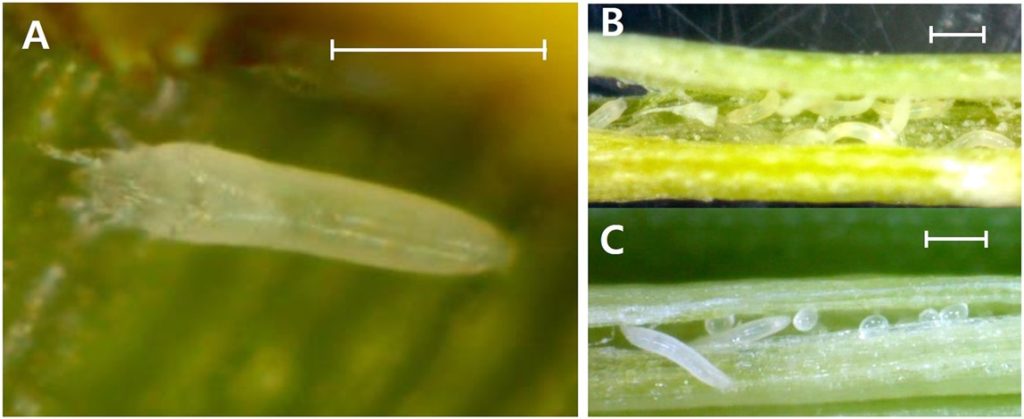
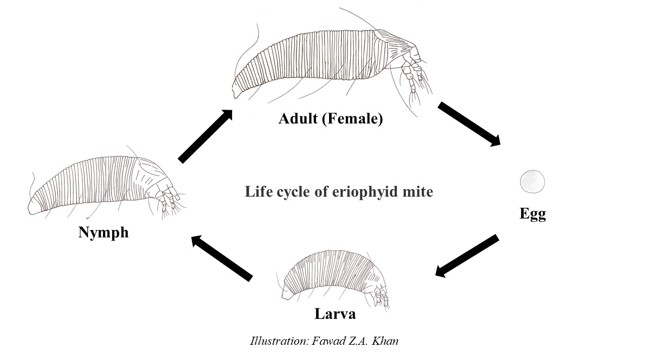
Others – zoysiagrass mite and buffalograss mite
The biology and management of zoysiagrass mite and buffalograss mite are similar to bermudagrass mite, except they attack zoysiagrass and buffalograss, respectively. Zoysiagrass mite feeds exclusively on Zoysia spp. and causes what is referred to as the “buggy‐whip” symptoms (Fig. 5) and marginal leaf curling rather than a witches’ brooming. Buffalograss mite feeding causes symptoms similar to bermudagrass mite damage, but the mite attacks only buffalograss (Bouteloua dactyloides).
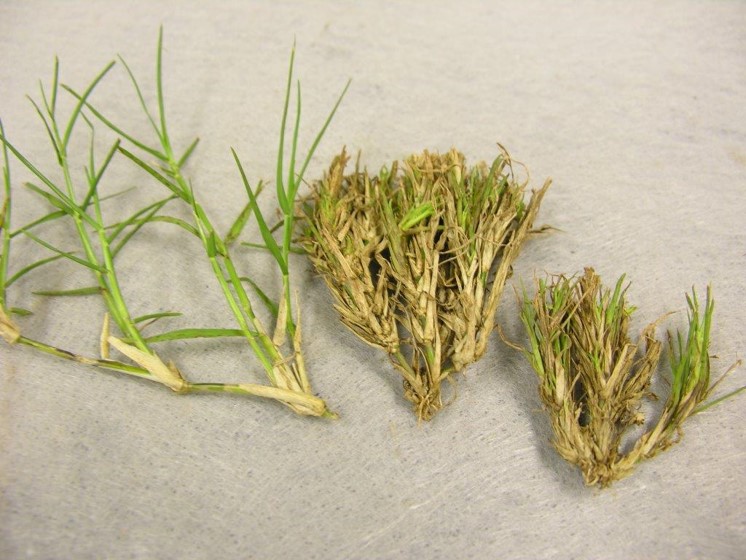
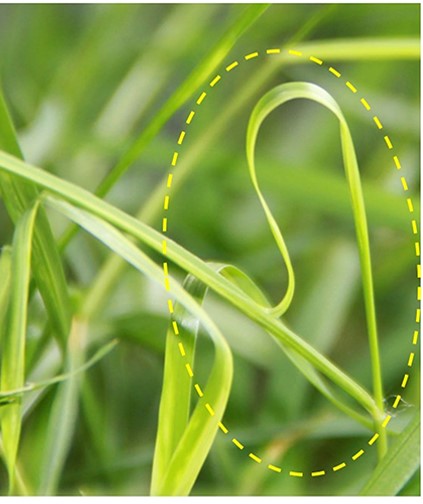
2. Two-spotted spider mite
Biology
The two-spotted spider mite (Fig. 6) is similar in appearance to the banks grass mite. It is an important herbivore and a pest of turfgrass and ornamental plants worldwide. This species has five life stages, including egg, larva, two nymphs (protonymph and deutonymph), and adult stage (Fig. 7). The females are larger than males. The eggs are spherical and transparent but turn darker before hatching. It takes about 8-17 days to complete the life cycle. During summer, all life stages may be present at the same time. Two-spotted spider mites are resilient and adaptable compared to the other mite species and attack more types of plants than any other mite.


Damage symptoms
The two-spotted spider mite feeds from the lower surface of the leaf. Initially, the infestation affects the leaf blades but later spreads across the plant. Due to multiple generations and quick breeding time, the two-spotted spider mites can heavily affect grass quickly. Severe infestations lead to yellowing and death of the grass.
Management
The two-spotted spider mite is naturally managed by several predatory arthropods, including phytoseiid mites. The use of non-selective acaricides is, therefore, not recommended as they can lead to the decline of beneficial mites. Excess fertilizer, especially nitrogen applications, can increase spider mite populations.
3. Clover mite
Biology
The clover mite (Fig. 8) is a pest of various turfgrasses and ornamental plants. As a typical spider mite, it has five life stages, i.e., egg, larva, two nymphs, and adult stage (Fig. 7). The eggs hatch into red-colored larvae with three pairs of legs. The nymphal stages have four pairs of legs. The adult stage has prominent long front legs, about 0.4 mm long. The adults are reddish brown with featherlike abdominal plates. Clover mites produce eggs without mating; the population comprises only female mites. A female lays up to 70 eggs during its lifetime. Clover mites are sensitive to high and low temperatures, so they aestivate and hibernate in the egg stage during the most extreme summer and winter months. Clover mites are most active during the spring and fall.

Damage symptoms
The rasping feeding habit of clover mites produces silver streaks on the turfgrass leaf blades. This damage produces a pale coloration of the leaves, and leaves die off. These symptoms are easily confused with winter injury as turfgrass emerges from dormancy. The symptoms are prominent adjacent to buildings. Clover mites can also become a serious nuisance pest during the fall and spring as they migrate in large numbers to the sun-facing sides of buildings. They may wander into houses through open doors, windows, cracks, and crevices. They do not bite humans or pets, but if crushed, they leave behind a red stain on contact surfaces.
Management
Currently, there is no study on the resistance of turfgrass species for clover mites. However, like many mites, infestations are often linked to drought conditions. A good irrigation schedule can lower population levels and make turfgrass more tolerant to feeding damage. There are no biological control agents, such as predators or parasitoids, reported on this mite. Pesticides do not offer effective control therefore not recommended.
4. Banks grass mite
Biology
The banks grass mite is an important pest of ornamental, forage, and turfgrasses (Fig. 9). It has five life stages – egg, larva, two nymphs, and adult stage (Fig. 7). The eggs hatch into the larval stage, which has three pairs of legs, then molt into protonymph with four pairs of legs. Adult females are larger than males. Banks grass mites are mostly green in color; however, during periods of food shortage or unfavorable weather, they may turn into a bright orange color. The mites overwinter as adults. During spring, the female lays eggs on the surface of grass blades or on webs created by the mites. The eggs hatch within three weeks. During warmer weather, the lifecycle may be completed in one week. When ready to disperse, they move to the tip of the grass blade and disperse by “ballooning” on the wind (Fig. 10).
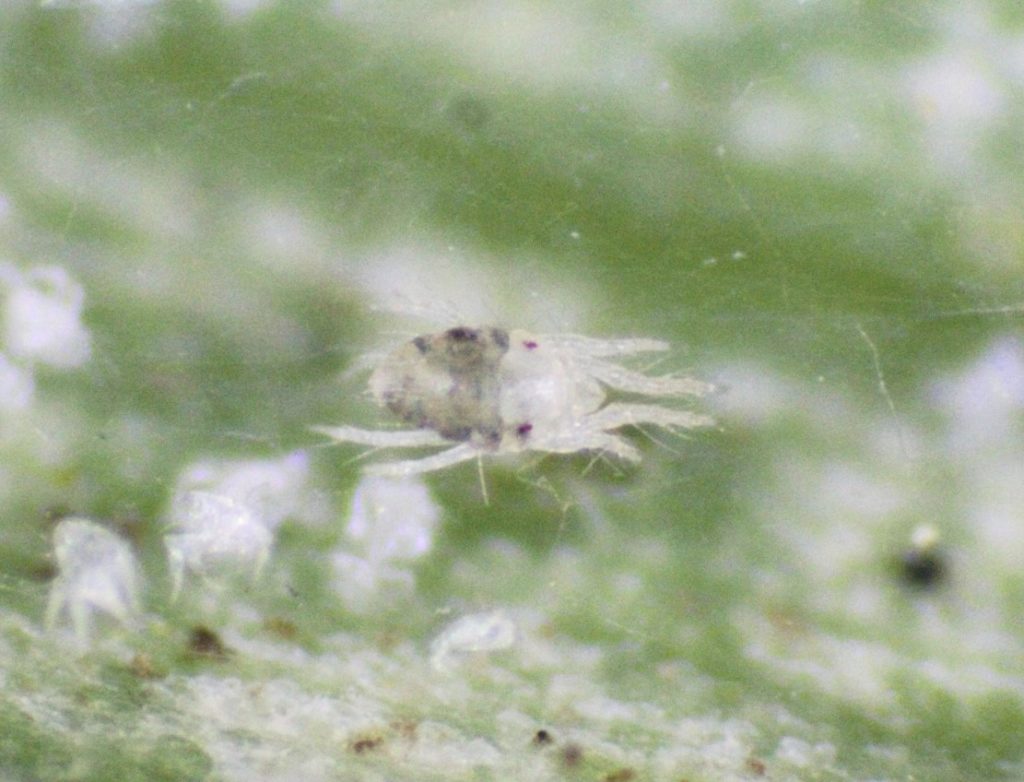

Damage symptoms
The damage starts with yellow stippling on the leaf blade. Prolonged feeding causes the leaf blade to wither and die. Feeding damage by banks grass mite is often confused with symptoms of drought on turfgrass.
Management
There are no studies that indicate the resistance of any turfgrass species or cultivars against banks grass mite. Mite damage is closely associated with drought, so a proper irrigation schedule can help reduce mite populations and increase turfgrass tolerance to feeding damage. Banks grass mite populations may also be controlled by a predator, the phytoseiid mite, Galendromus flumenis (Acari: Phytoseiidae). It is unknown if this predator is naturally present in Georgia turfgrass.
5. Winter grain mite
Biology
The winter grain mite (Fig. 11) is a pest of bluegrass, bentgrass, tall fescue, ryegrass, and other cool-season turfgrasses. The females can live up to 61 days, producing 30-65 eggs during a lifetime. The eggs hatch into larvae, which feed on the leaf blades, leaving behind silvery streaks. These mites are more active during late winter and early spring when temperatures are in the cooler range, indicating sensitivity to warmer temperatures.

Damage symptoms
The activity of winter grain mite causes severe damage to the leaf blade, leaving the tips silver. High feeding pressure can cause scorching and browning of the grass blades.
Management
The winter grain mite rarely causes turfgrass mortality, although the severity of feeding damage is difficult to predict. The primary management tactic is the use of adequate fertilizers when the feeding (based on soil test recommendations) damage is observed to allow for quick grass recovery from the damage.
Table for quick identification of common mites in turfgrass
| Mite pest | Appearance | Turfgrass affected | Damage symptoms |
| Bermudagrass mite | Worm-like | bermudagrass | Leaf sheath swelling and witches brooming symptoms in bermudagrass |
| Zoysiagrass mite | Worm-like | zoysiagrass | Yellowing coupled with buggy whip symptoms or the rolling of the marginal leaf |
| Buffalograss mite | Worm-like | buffalograss | Leaf sheath swelling and witches brooming symptoms in buffalograss |
| Two-spotted spider mite | Spider-like | Most turfgrasses | Webbing, chlorotic stippling, yellowing, and plant death. |
| Clover mite | Spider-like | Most turfgrasses | Silver streak development on the leaf blade, “winter-injury” like symptoms |
| Banks grass mite | Spider-like | Kentucky bluegrass, bermudagrass, St. Augustinegrass | Chlorotic stippling on grass blades, webbing under turf tillers, tip yellowing and dieback (similar to drought) |
| Winter Grain Mite | Spider-like | bluegrass, bentgrass, fescue, ryegrass | Silvery appearance on tips of blades, scorching, brown patch development, “winter-injury” like symptoms |
References
Ali A.D & Elmore C. L. (1989). Turfgrass Pests: University of California Cooperative Extension Service Publication No. 4053. Division of Agriculture and Natural Resources, University of California.
Capinera, J. L. (2008). Twospotted Spider Mite, Tetranychus urticae Koch (Acari: Tetranychidae). Encyclopedia of Entomology, 3997-4000.
Ganjisaffar, F., & Perring, T. M. (2015). Prey stage preference and functional response of the predatory mite Galendromus flumenis to Oligonychus pratensis. Biological Control, 82, 40-45.
Ganjisaffar, F., & Perring, T. M. (2017). A life table analysis to evaluate biological control of banks grass mite using the predatory mite, Galendromus flumenis (Acari: Phytoseiidae). Systematic and Applied Acarology, 22(1), 7-14.
Iskra, A. E., Woods, J. L., & Gent, D. H. (2019). Stability and resiliency of biological control of the twospotted spider mite (Acari: Tetranychidae) in hop. Environmental entomology. doi: 10.1093/ee/nvz071
Jung, D. O., Park, D. S., Shim, J. K., Lee, S., Pyee, J., & Lee, K. Y. (2019). Occurrence and molecular identification of the zoysiagrass mite Aceria zoysiae (Acari: Eriophyidae) in turfgrasses in Korea. Entomological research, 49(1), 72-77.
Narayan, D. S. (1962). Morphological, biological and ecological studies on the winter grain mite, Penthaleus major (Dugés), Penthaleidae; Acarina. Part 1. J. Zool. Soc. India, 14, 45-63.
Potter, D. A., & Braman, S. K. (1991). Ecology and management of turfgrass insects. Annual Review of Entomology, 36(1), 383-406.
Reinert, J. A., Taliaferro, C. M., & McAfee, J. A. (2007, June). Susceptibility of Bermudagrass (Cynodon) varieties to bermduagrass mite (Eriophyes cynodoniensis). In II International Conference on Turfgrass Science and Management for Sports Fields 783 (pp. 519-528).
Ruckert, A., Allen, L. N., & Ramirez, R. A. (2018). Combinations of plant water-stress and neonicotinoids can lead to secondary outbreaks of Banks grass mite (Oligonychus pratensis Banks). PloS one, 13(2), e0191536.
Umina, P. A., Hoffmann, A. A., & Weeks, A. R. (2004). Biology, ecology and control of the Penthaleus species complex (Acari: Penthaleidae). Experimental & applied acarology, 34(3-4), 211-237.
Watschke, T. L., Dernoeden, P. H., & Shetlar, D. J. (2013). Managing turfgrass pests. CRC Press.